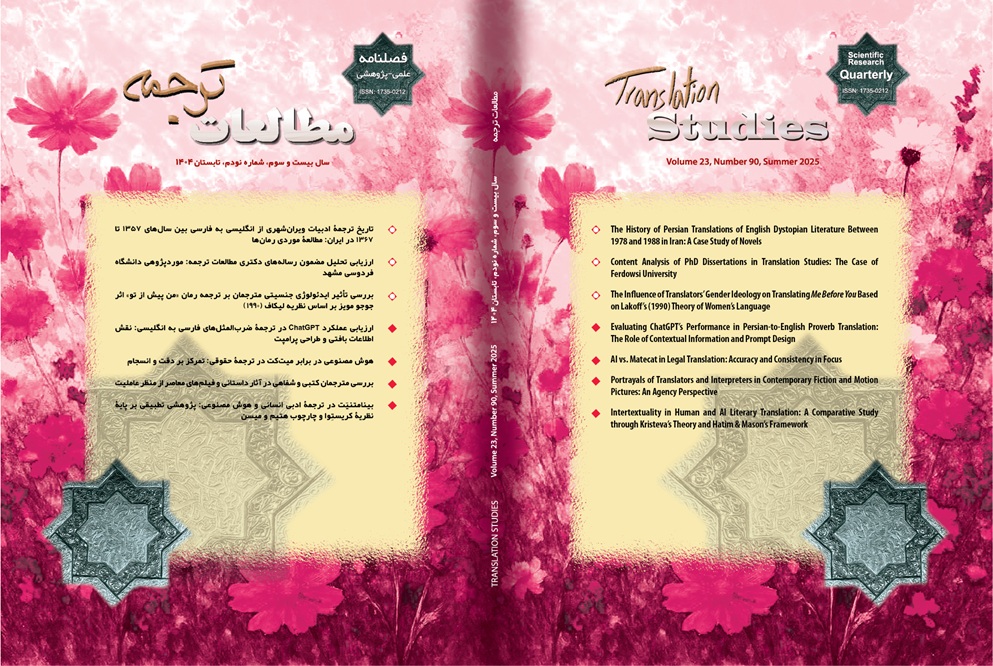Intertextuality in Human and AI Literary Translation: A Comparative Study Through Kristeva’s Theory and Hatim & Mason’s Framework
Abstract
Grounded in Kristeva’s (1966) theory of intertextuality and Hatim and Mason’s (1990) intertextual framework, the present research addresses the representation of intertextual references in Persian translations of six English novels. The corpus includes translations by three human translators—Hosseini, Badiei, and Karimi Hakkak—and an AI language model, GPT-4. To this end, using literary criticism, the most frequent intertextual elements were identified and compared with the translations. The findings reveal that human translators often employ strategies such as accommodation and explanation, drawing on classical Persian literature to recreate the intertextual layers of the source text, mirroring the original authors’ reliance on earlier literary works. The results further indicate that GPT-4, when effectively prompted, utilizes strategies like adaptation and explanation, showing similar performance to human translators in many cases, though its use of classical Persian literature remains limited. The outcomes highlight that both translation and writing are intertextual processes. While AI language models like GPT-4 have made significant progress, further development is needed to more effectively leverage the potential of classical Persian literature in these models. Utilizing classical literature in translation not only enriches translated works but also plays a key role in preserving target language and culture in the face of global linguistic shifts.
References
Allen, G. (2011). Intertextuality. Routledge.
Barthes, R. (1974). S/Z (R. Howard, trans.). Hill and Wang. (Original work published 1970).
Brala Vukanović, M. (2025). Translating (metaphors) in the age of AI: Opportunities, challenges, and implications for the EFL classroom. ELOPE: English Language Overseas Perspectives and Enquiries, 22(1), 185–201. https://doi.org/10.4312/elope.22.1.185-201
Conrad, J. (1996). Lord Jim: An authoritative text (T. C. Moser, Ed.). Stanford University Press.
Conrad, J. (1996). Lord Jim. (S. Hosseini, Trans.). Niloufar. (Original work published 1900). (In Persian).
De Nooy, J. (1998). Derrida, Kristeva and the dividing line: An articulation of two theories of difference. Garland Publishing.
Farahzad, F. (2009). Translation as an intertextual practice. Perspectives: Studies in Translation Theory and Practice, 16 (3–4), 125–131. https://doi.org/10.1080/09076760802547462
Faulkner, W. (1982). Light in August. Chatto & Windus. Retrieved from Digital Library of India Item 2015.124648
Faulkner, W. (2021). Light in August. (S. Hosseini, Trans.). Niloufar. (Original work published 1932). (In Persian).
Fielding, H. (1982). The history of Tom Jones, a foundling. Universal Offset Printers.
Fielding, H. (2007). The history of Tom Jones, a foundling. (A. Karimi Hakkak, Trans.). Niloufar. (Original work published 1749). (In Persian).
Fowler, D. (2000). Roman constructions: Readings in postmodern Latin. Oxford University Press.
Gajšt, N. (2025). Applications of AI-driven tools in translating and drafting commercial correspondence – A Slovenian-English perspective. ELOPE: English Language Overseas Perspectives and Enquiries, 22(1), 153–170. https://doi.org/10.4312/elope.22.1.153-170
Hatim, B., & Mason, I. (1990). Discourse and the translator. Routledge. https://doi.org/10.4324/9781315846583
Hatim, B. & Mason, I. (1997). The translator as communicator. Routledge.
Hassani, G., Malekshahi, M., & Davari, H. (2025). AI-powered transcreation in global marketing: Insights from Iran. ELOPE: English Language Overseas Perspectives and Enquiries, 22(1), 203–221. https://doi.org/10.4312/elope.22.1.203-221
Joyce, J. (1996). A portrait of the artist as a young man. (J. Belanger, Ed.). Wordsworth Classic.
Joyce, J. (2001). A portrait of the artist as a young man. (M. Badiei, Trans.). Niloufar. (Original work published 1916). (In Persian).
Joyce, J. (1980). Ulysses. Planet Pdf. Retrieved from http://www.planetpdf.com
Joyce, J. (2002). Ulysses. (M. Badiei, Trans.). Niloufar. (Original work published 1922). (In Persian).
Kristeva, J. (1980). Desire in language: A semiotic approach to literature and art (T. Gora, A. Jardine, & L. S. Roudiez, Trans.; L. S. Roudiez, Ed.). Columbia University Press. (Original work published 1966).
Kourdis, E. (2024). Kristeva’s impact on translation and the interplay of intertextuality, transposition and intersemiosis. Acta Nova Humanistica, 1(1), 143–159. https://doi.org/10.33919/ANHNBU.24.1.9
Landers, C. (2001). Literary translation: A practical guide. Multilingual Matters.
Melville, H. (2012). Moby Dick. Arcturus Publishing.
Melville, H. (2015). Moby Dick. (S. Hosseini, Trans.). Niloufar. (Original work published 1851). (In Persian).
Neubert, A., & Shreve, G. (1992). Translation as text. Kent State University Press.
Schäffner, C. (2012). Intercultural intertextuality as a translation phenomenon. Perspective: Studies in Translation Theory and Practice, 20(3), 345–364. https://doi.org/10.1080/0907676X.2012.702402
Tahmasbi Boveiri, S., Nejadansari Mahabadi, D., Shahnazari, M., & Afrouz, M. (2025). The essential role of intertextual awareness in English literary translation: A case study of Saleh Hosseini’s works. Iranian Journal of Translation Studies, 23(89), 25–43. https://dorl.net/dor/20.1001.1.17350212.1404.23.1.2.2
Venuti, L. (2009). Translation, intertextuality, interpretation. Romance Studies, 27(3), 157–173. https://doi.org/10.1179/174581509X455169
Zhang, W., & Zhao, N. (2015). Analysis of the translators’ social and psychological trends from the perspective of intertextuality. Journal of Language Teaching and Research, 6 (1), 157–162. http://dx.doi.org/10.17507/jltr.0601.19
Zupan, S., Pavličič, Z., & Fabčič, M. L. (2025). Machine translation of independent nominal phrases in technical texts. ELOPE: English Language Overseas Perspectives and Enquiries, 22(1), 171–184. https://doi.org/10.4312/elope.22.1.171-184
Downloads
Published
How to Cite
Issue
Section
DOR
License
Copyright (c) 2025 Sajjad Tahmasbi Boveiri, Dariush Nejadansari Mahabadi, Mohammadtaghi Shahnazari, Mahmoud Afrouz

This work is licensed under a Creative Commons Attribution-NonCommercial 4.0 International License.
Copyright Licensee: Iranian Journal of Translation Studies. This article is an open access article distributed under the terms and conditions of the Creative Commons Attribution–NonCommercial 4.0 International (CC BY-NC 4.0 license).





